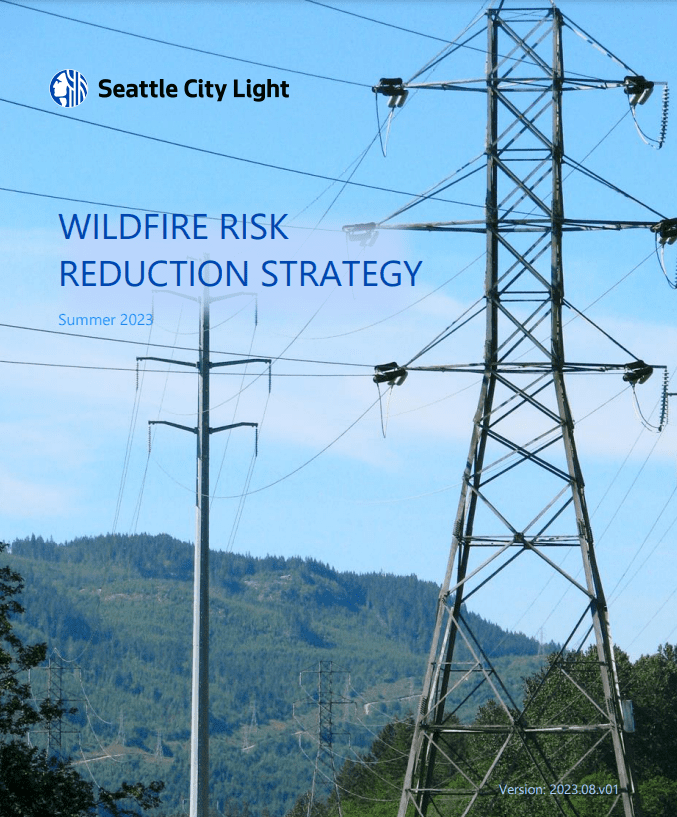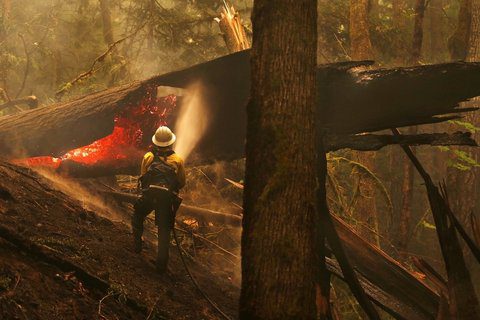 Wildfire smoke from the 2015 Goodell Creek fire near Newhalem.
Wildfire smoke from the 2015 Goodell Creek fire near Newhalem. The warmer and drier conditions driven by our changing climate are increasing the frequency and intensity of wildfires. Even the traditionally wet forests of the Pacific Northwest are now at greater risk than in the past, as are the buildings and infrastructure interlaced within the forests.
Seattle City Light has been following these changing wildfire conditions and seen our share of wildfire as well. Eight years ago during the Goodell Creek fire, we evacuated the town of Diablo and took our hydroelectric dams temporarily offline. Earlier this month, also near our Skagit Hydroelectric Project, the Sourdough Mountain fire got within proximity of the town of Diablo, Diablo dam and its powerhouse early in the fire’s activity, but it has since shifted away from the area.
While the risk of our own assets igniting fires is low, we recognize that wildfire risk is increasing even in typically soggy areas of the state. In assessing these situations, we have proactively taken action to reduce the risk of starting wildfires and mitigate the potential impacts of wildfire on energy facilities, electricity delivery and the communities we serve.
In 2022, we developed our first wildfire preparedness draft. This year, after internal and external reviews, we have now refined our Wildfire Risk Reduction Strategy (WRRS) with expanded measures and strategies. Over the next year, we will be implementing and advancing these strategies, and we recognize that new legislation could influence these plans.
What is in the Wildfire Risk Reduction Strategy?
City Light has actively managed wildfire risk for years. The WRRS addresses the potential for our assets and infrastructure to cause wildfires and be impacted by them. The key elements of our strategy include the following:
- Risk assessment to understand the risk of electric grid assets causing wildfires, as well as the risk of those assets being affected by wildfires.
- Risk mitigation to reduce wildfire risk, including actions such as grid hardening and vegetation management.
- Emergency management to monitor for high-risk weather conditions when fires are more likely to occur and to respond when those conditions arise.
- Stakeholder engagement with the communities that may be affected by wildfire or City Light’s response to wildfires, and coordination with emergency response organizations and municipalities to respond to events.
- Governance and accountability to designate responsibility for execution of the WRRS and provide oversight to improve the strategy as it is executed.
When managing the risk that wildfires pose, City Light’s WRRS has both risk reduction and risk mitigation elements.
- Reduction refers to preventive steps taken to decrease the likelihood of a wildfire occurring or the extent of the damage it could cause.
- Mitigation refers to steps designed to manage or reduce the impact or consequence of a wildfire once it has occurred.
The measures and strategies for each element vary. For instance, risk reduction may include:
- adhering to building codes for fire resistance.
- conducting controlled burns.
- maintaining a defensible space around structures.
- robust vegetation management.
Risk mitigation can include:
- efficient firefighting strategies.
- evacuation plans.
- insurance arrangements.
- post-fire recovery plans.
In line with these strategies, we have prioritized minimizing potential damage through risk reduction plans that deter wildfire occurrences while also ensuring we are prepared to respond effectively and recover quickly in the event of a wildfire.
How will the Wildfire Risk Reduction Strategy change in the future?
We prioritize safety and preparedness for our employees and our customers. Maintaining a culture of preparedness is a priority, and we work year-round to ensure our electric grid, transmission lines, system equipment and facilities are resilient to inclement weather. Our approach to the risk of wildfire is no different.
This document will be updated regularly as we refine existing preventive measures, learn new ways to assess risk, and respond to and recover from threats and hazards. We are not alone in wildfire preparedness, and we understand how valuable it is to coordinate our efforts with other city departments, the county, the state, and other utilities to better understand how to reduce the risk of wildfires and mitigate their effects.
We are also hoping that you, too, will partner with us in protecting our forests and our infrastructure. The overwhelming majority of wildfires are caused by human activity, and so please help protect yourself and others by:
- adhering to no-burn bans at home or when camping.
- carefully attending campfires and other controlled burns.
- informing emergency services immediately if you see smoke.
We want to thank the City Light team who led this effort and our peers and partners for their expertise and support. We also want to thank you, our customers, for your trust as we continue working to power and protect our communities. While each year brings new challenges, our goals remain the same: to reduce the potential impacts of wildfire on meeting our mission to deliver affordable, reliable and environmentally responsible energy services to our customers.

